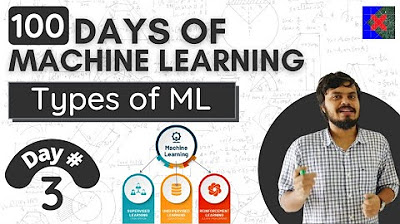Lecture 1.6 | well defined learning problems | Machine Learning Techniques | #aktu #mlt #unit1 #ml
Summary
TLDRThis video explores the concept of well-defined learning problems in machine learning. It delves into the key characteristics that make a problem well-defined, including clear objectives, measurable outcomes, relevant input and output data, and evaluation metrics. The video emphasizes how well-structured data is essential for model development and performance evaluation. Practical examples like image classification, sentiment analysis, and recommendation systems are used to highlight these principles. The content provides a foundational understanding for identifying, solving, and evaluating learning problems in the context of machine learning.
Takeaways
- 😀 A well-defined learning problem has clear objectives, making it easier to develop and evaluate algorithms.
- 😀 A well-defined problem ensures that the input data and output data are relevant, measurable, and structured.
- 😀 Clear objectives are crucial in any problem definition, specifying what needs to be achieved and how.
- 😀 Input data must be structured, accessible, and relevant to the problem for effective machine learning applications.
- 😀 Output data must be measurable, typically in the form of predictions or classifications that help evaluate success.
- 😀 Evaluation metrics, such as accuracy or F1 score, are necessary to assess the performance of algorithms in solving the problem.
- 😀 Problems are categorized as well-defined if they follow key characteristics: clear objectives, measurable results, relevant input data, and proper evaluation metrics.
- 😀 If a problem lacks structured and relevant input data or fails to have clear objectives, it is considered poorly defined.
- 😀 Examples of well-defined learning problems include image classification, sentiment analysis, and recommendation systems.
- 😀 For problems like sentiment analysis, the input might be text (e.g., tweets), and the output would be the sentiment score or analysis.
- 😀 Well-defined problems form the basis for designing effective machine learning models and evaluating their performance accurately.
Q & A
What is the definition of a well-defined learning problem in machine learning?
-A well-defined learning problem is one that has clear objectives and measurable goals. It also involves identifiable input and output data, which allows for effective algorithm development and evaluation.
Why is having clear objectives important in a well-defined learning problem?
-Clear objectives are crucial because they define the problem's goal, ensuring that the machine learning model can be developed with a specific purpose and evaluation criteria in mind.
What role does input data play in a well-defined learning problem?
-Input data is essential for training the machine learning model. It should be well-structured and easily accessible so that the model can understand and process the information effectively.
What does 'well-structured' data mean in the context of machine learning?
-Well-structured data refers to data that is organized in a way that is easily interpretable by machine learning algorithms. This includes data that is in a consistent format, with relevant features that can be used for training.
Can a problem with unstructured or irrelevant data be considered a well-defined learning problem?
-No, if the input data is unstructured or irrelevant to the problem at hand, the problem cannot be considered well-defined. Relevant and structured data is necessary for effective model training.
What is the importance of output data in a well-defined learning problem?
-Output data represents the predictions or results of the model. It must be clearly defined to evaluate whether the problem has been solved successfully and to measure the performance of the algorithm.
How do evaluation metrics contribute to the definition of a learning problem?
-Evaluation metrics are used to assess the performance of the model. These metrics, such as accuracy or F1 score, help determine how well the model has achieved its objectives and solve the problem.
What are some common examples of well-defined learning problems?
-Examples of well-defined learning problems include image classification, sentiment analysis, and recommendation systems, where clear objectives, structured input data, and measurable outputs exist.
What makes image classification a well-defined learning problem?
-In image classification, the problem is well-defined because the goal is clear (classify images), the input data (images) is structured, and the output (predicted class labels) is clearly defined and measurable.
How does sentiment analysis fit into the concept of a well-defined learning problem?
-Sentiment analysis is well-defined because it involves clear objectives (determining sentiment from text), structured input data (text data from social media or tweets), and measurable output (sentiment scores or classifications).
Outlines

Cette section est réservée aux utilisateurs payants. Améliorez votre compte pour accéder à cette section.
Améliorer maintenantMindmap

Cette section est réservée aux utilisateurs payants. Améliorez votre compte pour accéder à cette section.
Améliorer maintenantKeywords

Cette section est réservée aux utilisateurs payants. Améliorez votre compte pour accéder à cette section.
Améliorer maintenantHighlights

Cette section est réservée aux utilisateurs payants. Améliorez votre compte pour accéder à cette section.
Améliorer maintenantTranscripts

Cette section est réservée aux utilisateurs payants. Améliorez votre compte pour accéder à cette section.
Améliorer maintenantVoir Plus de Vidéos Connexes

Types of Machine Learning for Beginners | Types of Machine learning in Hindi | Types of ML in Depth

DL.1.1. Fundamentals of Deep Learning Part 1

What is Machine Learning?

V1. Data Types | Linear Algebra for Machine Learning #MathsforMachineLearning

Bayesian Estimation in Machine Learning - Training and Uncertainties

Machine Learning Fundamentals A - TensorFlow 2.0 Course
5.0 / 5 (0 votes)
